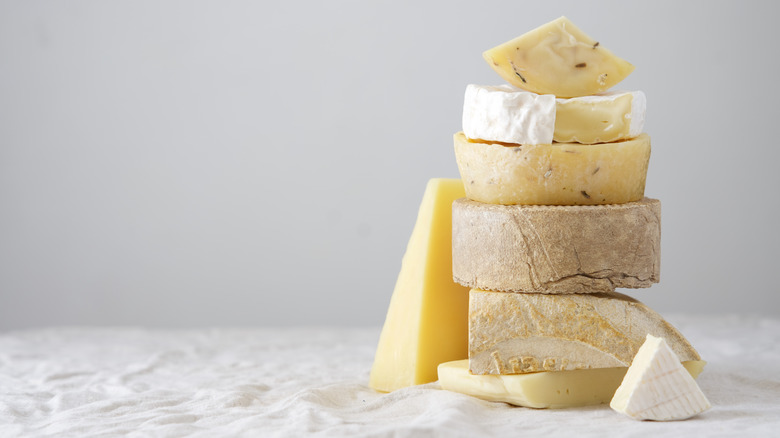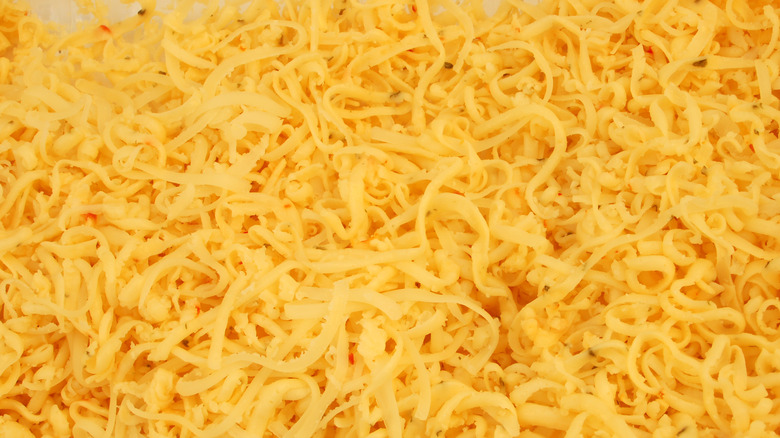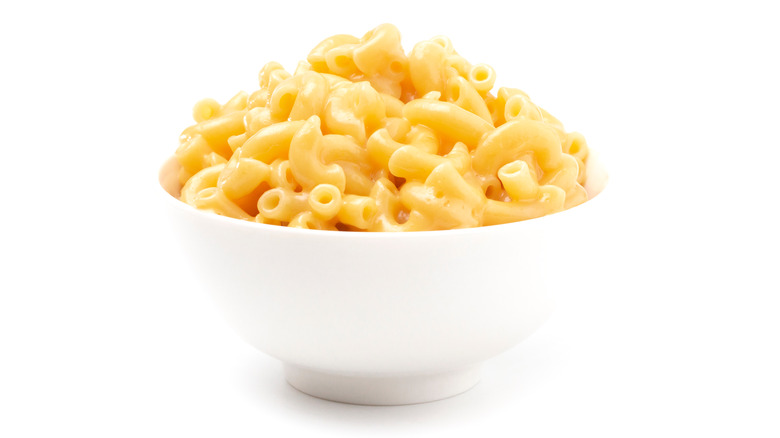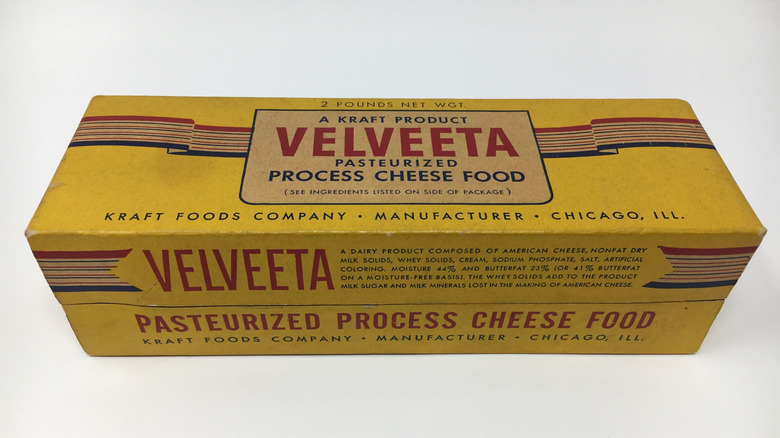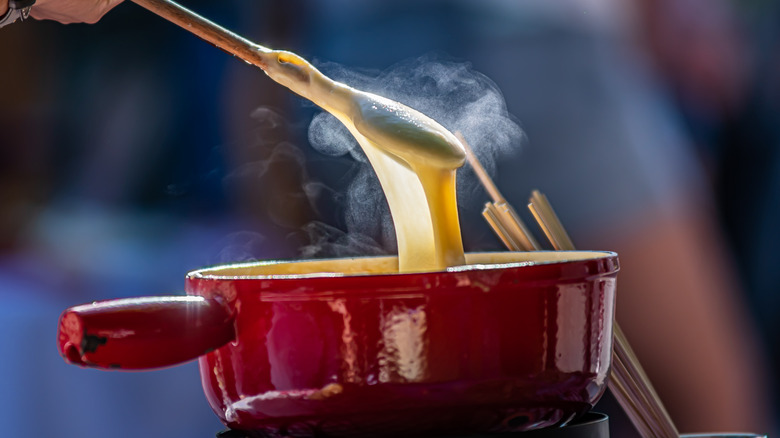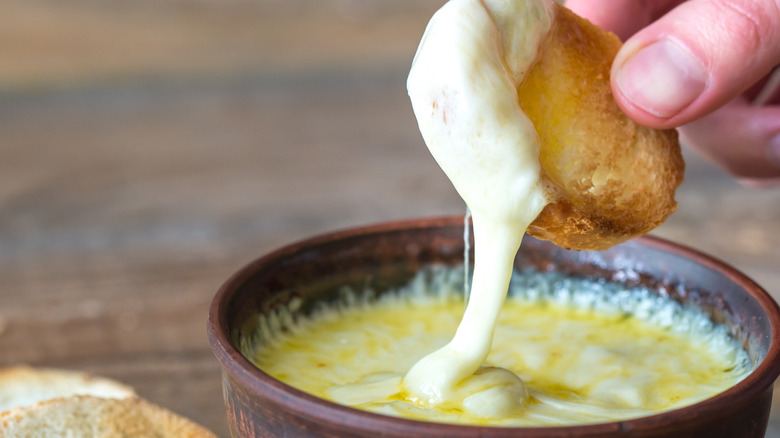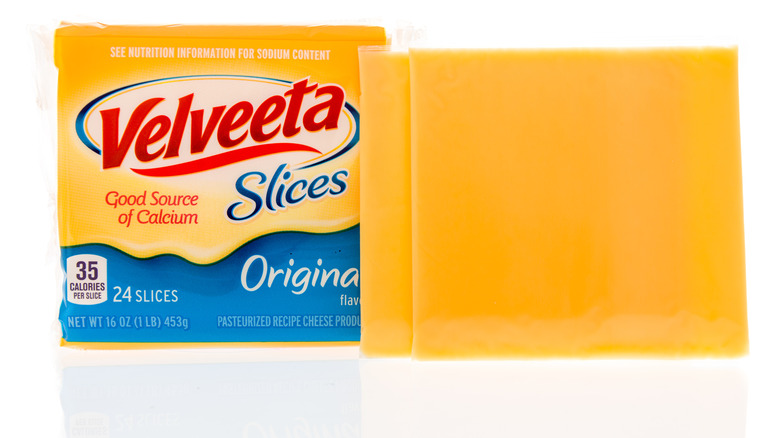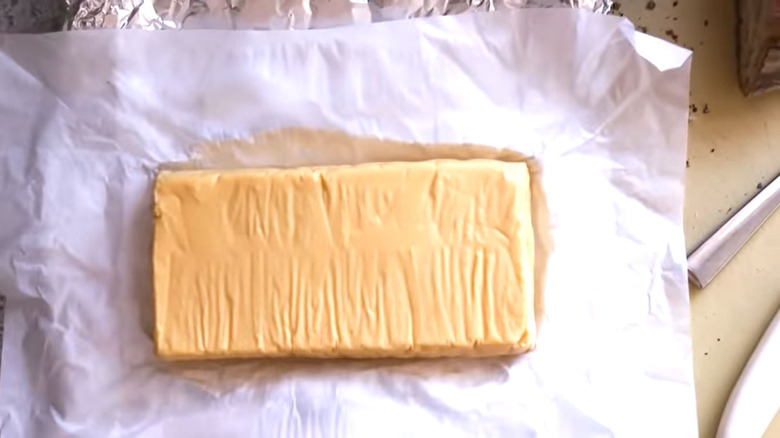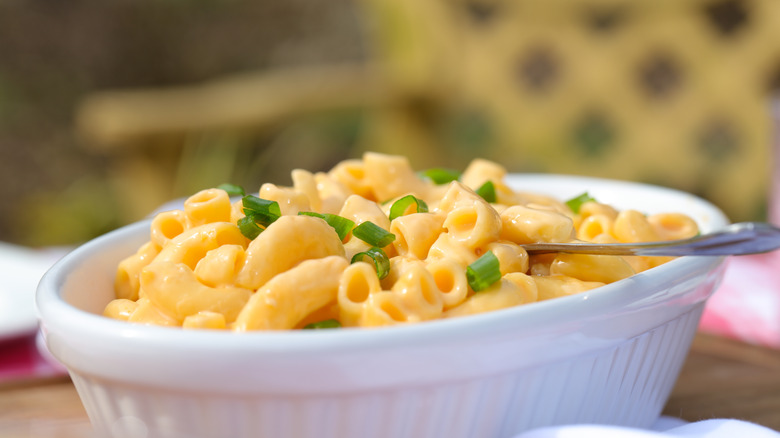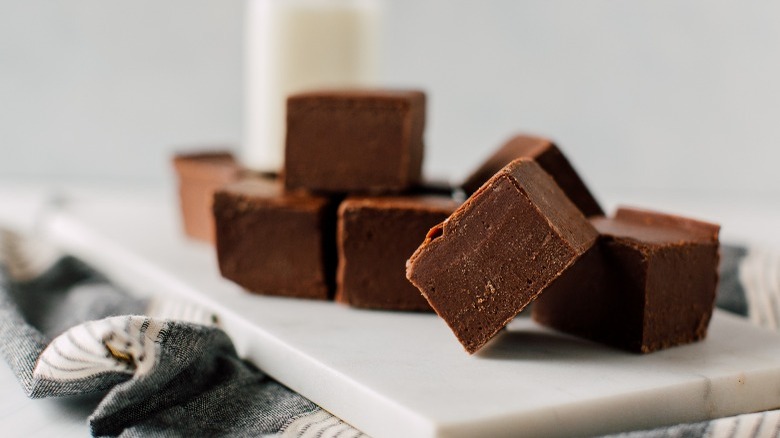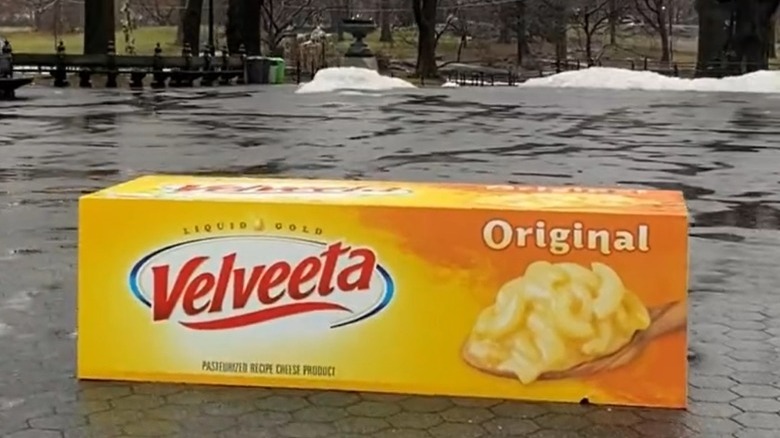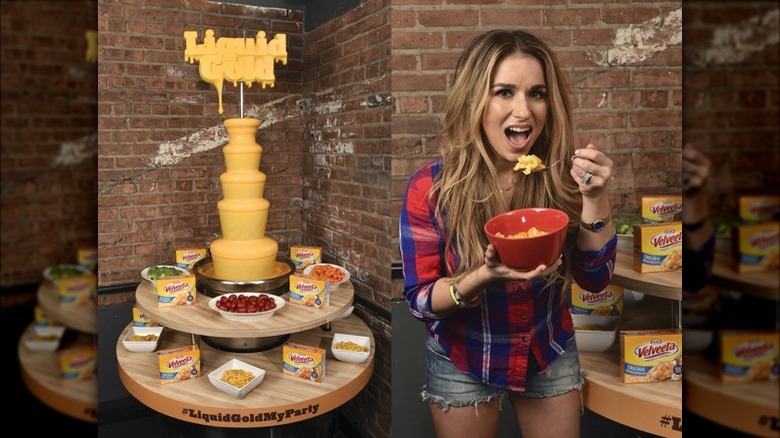The Untold Truth Of Velveeta
No matter how much your tastes have evolved from the time you were eating school lunches and everything with ketchup, Velveeta probably has a special place in your list of guilty pleasures. It might be one of the most unnatural colors you'll see in the supermarket, and it might be of a completely questionable texture, but there's no denying that magic happens when you melt it. What's the deal with this super-processed but super-popular cheese product?
Velveeta was created as a way to reuse extra cheese
Velveeta wasn't so much discovered as it was invented, and even stranger is the fact that it's actually the second cheese invented by Swiss immigrant Emil Frey. Frey emigrated to the US with his father, who was also a farmer and cheese maker, and eventually ended up working for the Monroe Cheese Company in New York. First, he was tasked with creating a cheese that could be used in lieu of an imported cheese called Bismarck, and he did. His first cheese was the soft, spreadable, and amazing Liederkranz, and it was so popular the factory was shipping out more than a ton of cheese a day just to keep up with demand. That was in 1889, and it wasn't until 1918 that he discovered his second famous cheese.
At the time, the company had opened another location that mainly produced Swiss cheese. They had a problem, though — it was difficult to sell cheese wheels that were damaged, and that was a lot of product they didn't want to go to waste. Knowing Frey had already had success creating new cheeses, they sent him some samples and asked him to come up with a product that used these cheese scraps. After some serious experimentation — most of which was done on his own home stove — he came up with a product that not only used all the cheese scraps that might have otherwise gone to waste, but he also produced a cheese with a texture unlike any other. It was the texture — described as velvety — that he named Velveeta for.
This cheese product was invented with weird science
Frey's experients didn't just lead him to a way to use cheese that would otherwise be thrown away, but it also led him to some weird science. Melt most "real" cheese and you'll end up separating the oil from it in something of — to use the technical term — a yucky mess. Melt Velveeta, though, and you'll get an amazing guilty pleasure that's perfect for things like queso.
It's all complicated science, but basically, what's going on with real cheese when you heat it is the creation of a state where caseins (the proteins in milk) don't mix with water. While that's what makes cheese, well, cheese, it's also what makes the fat separate from most cheeses when you melt it.
Frey was following in the footsteps of two men named Fritz Settler and Walter Gerber, Swiss researchers who were trying to find a cheese product that would melt. When they added sodium citrate to their cheesey experiments, they found they could melt cheese and reform it into the familiar, Velveeta-shaped block. That's because the sodium citrate changes the state of those caseins, and allows them to form something much more soluble and resistant to heat. Kraft actually describes it as reversing the process that made cheese in the first place, then stopping at a point before it breaks down completely.
It got a major boost in popularity during the Depression and World War Two
From the 1920s to the 1940s, the US went from the Great Depression right into World War II... and that was on the heels of the first World War. Velveeta — and Kraft's Mac & Cheese — got a massive popularity boost at the time because its affordability allowed families to stretch their pennies even farther and still keep food on the table.
During the Depression, an average family's food budget for the week was somewhere around $9, although many were forced to make do with even less than that. So, when families were faced with feeding four, five, or more people on pennies a day, getting growing kids all the nutrition they needed was of the utmost importance. Milk was expensive, but Velveeta was not.
By the time World War II started, milk and cheddar cheese were among the first items to be rationed on the home front. While supplying the troops was first priority, keeping everyone at home healthy and strong was a close second, and Kraft's wartime campaign made it clear that Velveeta was an affordable, healthy way to make sure your entire family got all the goodness they needed to pull their weight and get things done. As a bonus, Velveeta was also marketed as a way to make those leftovers into something the family wanted to eat, and make it easier to guarantee nothing went to waste. Velveeta was affordable, healthy, and firmly cemented into popular culture as the stuff of fighting the good fight.
It was advertised as a super-healthy, nutritious option
Each one-pound brick of Velveeta has a recommended 16 servings, and if you look at the nutritional information through 21st century eyes, those servings are pretty terrifying. Each serving has 80 calories (50 from fat), 6 grams of fat (4 from saturated fat), and 3 grams of carbs (with 2 that come from sugars). There's a ton of sodium, too — 410 mg — and you're only getting 15 percent of your daily dose of calcium. That means Velveeta is a guilty pleasure today, and that all makes it even more surprising that it wasn't just marketed as an affordable way to feed a family, but as a super-healthy way to feed them, too.
Velveeta was a 1930s-era superfood, on paper, at least. That's literal, as the American Medical Association declared Velveeta was chock full of super-nutritious goodness. That was in 1931 and from there, there was no looking back. Surveys done in the 1930s even found that about two thirds of Americans liked cheese product better than actual cheese, and there was no reason for them to believe it was anything but as healthy as it was good. There were university studies done, too, with Rutgers University confirming the AMA's belief that Velveeta included everything needed for "firm flesh."
Vintage Velveeta recipes are just bizarre
Kraft wanted to give housewives all the tools they needed to make dinner taste good (aside from their cheese, of course). They put out a whole bunch of recipes to help families get the most out of Velveeta and keep everyone from getting tired of the same, boring old grilled cheese sandwiches. That's admirable enough, but some of the ideas were just downright bizarre.
If you were looking for something to serve at a party, you might have come across Kraft's suggestion for Hawaiian-inspired party foods, and you can make them right now! Just take half of a toasted bun, apply a generous layer of peanut butter, add a slice of pineapple, a slice of Velveeta, then leave in the oven enough to melt the cheese. Top with a marachino cherry, and you had the makings of a party platter that was sure to delight!
Velveeta was good for breakfast, too, and a Velveeta jelly omelet might have been the perfect way to start your day off right. Most of this recipe doesn't sound too bad, and it's basically a 4-egg omelet with Velveeta folded into the eggs. Where it starts to get a little sketchy is with Kraft's suggestion to top it with your favorite jelly (they recommend the tart kind) and some parsley, because why not? There's also offerings like the Velveeta strata, which was basically a casserole made from a bread layer, a Velveeta layer, another bread layer, then a slather of eggs and milk... also to be served with jelly. There were Velveeta pizzas, an olive macaroni and cheese casserole, and a Velveeta dish from the family gatherings of The Glamorous Housewife. That recipe came from memories of years of holiday dinners, and it was literally only pearl onions melted in Velveeta cheese, and according to her, it tastes exactly as good as it sounds.
It's the backbone of a presidential tradition
Not all Velveeta recipes are questionable to modern tastes, and if you still use a brick of Velveeta to whip up some queso dip on every occasion you can rationally come up with, you're in good company. Before, during, and after his presidency, Lyndon B. Johnson never stopped being a Texan, and huge barbecues in his hometown of Stonewall were a regular occurrence. Velveeta was always on the menu, in the form of a queso dip made with Rotel tomatoes.
It was such a hit that it even made it into an official cookbook, one assembled by the San Antonio Symphony League. Lady Bird Johnson contributed it in 1976, and her version called for half a pound of cheese and half a can of tomatoes, melted together and served in the familiar way as a dip on corn chips. She also said the cheesey tomato mix was good as a spread on crackers or toast, and that it could also be used as a filling for hard-boiled eggs or as a dip for celery.
The traditions continued, and Texas-inspired galas continue to feature Velveeta on the menu. In 2005, the chairman of the Black Tie & Boots Inaugural Ball published his list of ingredients to a successful gathering. Third on the list (after chips and salsa) was 300 pounds of Velveeta.
We're eating more and more of it all the time
The internet might make us think we're being more health-conscious all the time, but there's a big difference between what we see (and post) on the internet and real life. In 2014, the steadily-climbing consumption of Velveeta led to a shortage that the internet quickly dubbed cheesepocalypse. Just what happened to cause the shortage wasn't entirely specified by Kraft, but according to Bloomberg, it likely has something to do with the increasing popularity of this processed cheese food. Between 2013 and 2014 alone, sales of Velveeta increased by 23.7 percent, while brand sales rose by 16.3 percent.
The trend continued in 2015, for a terrible reason. When Kraft crunched the numbers, they found that a large percentage of their sales were driven by outlets like Family Dollar. That's because an ever-increasing percentage of the population who find themselves living on an increasingly tight budget is turning to dollar and discount stores to get the basics at a fraction of the price. As baby boomers adapt to life on a fixed pension, they're also heading to dollar stores to pick up essentials, and that includes the Velveeta they remember from their childhoods.
Velveeta is more upsetting to lactose intolerant people than many real cheeses
It's not easy being lactose-intolerant. Since dairy is right out, that means cheese is too... but Velveeta isn't technically cheese, so that should be acceptable, right?
Not so fast. For the estimated 65 percent of the world's population that has some sort of difficulty with eating lactose, there certain kinds of cheeses that many can tolerate (think aged cheeses like Parmesan), but Velveeta is absolutely intolerable to most.
When it comes to what a lactose-intolerant person can actually eat, some people are fine with tiny amounts of lactose. Parmesan, for example, contains less than 3 percent lactose, and other low-lactose cheeses, like Camembert and Muenster, contain less than 2 percent. While lactose content in some more naturally formed cheese can vary, the regular process that makes Velveeta means that we know exactly how much lactose is going to be in it, and it's a whopping 9.3 percent. Needless to say, that takes it right off a lot of tables.
You can make it at home
There's a lot about Velveeta to love. But even if you love it, you might find it hard to serve with the nutritional information that makes it cheese product instead of actual cheese, and that's why some people have gone above and beyond to figure out just how you can make it right in your own kitchen. Wired kitchen wizards have figured out how to recreate Velveeta using a handful of other types of cheeses and ingredients like white wine, kosher salt, and that sodium citrate that's pretty much responsible for making Velveeta the smooth, creamy cheese it is.
If you don't happen to have sodium citrate on hand, the Brown-Eyed Baker has another version of homemade Velveeta that you can make in a loaf pan and slice up — and melt — just like the real thing. This one calls for a base of cheddar cheese, some dry milk powder, and unflavored gelatin. Now, you can make all the queso you want and know exactly what went into making it!
There's been fan fiction written about it
How much do you love Velveeta? Do you really, really love it? Do you love it enough to write fan fiction about it?
Fan fiction is a strange sort of phenomenon, and most of it's written about favorite movies or television shows. It turns out all you really need is massive fans, though, and Velveeta has that. There's this oddly wonderful piece of fan fiction called The Velveeta Rabbit, and it tells the story of the journey of a rabbit who has been formed from a block of Velveeta.
That's not all there is, and some enterprising fan fic writers have managed to combine Velveeta with everything from Dragonball Z to Harry Potter. It's shown up in Avengers fan fiction, too, proving that absolutely everyone loves this oddly-colored, orange cheese product — even, apparently, superheroes.
Do you need to refrigerate Velveeta cheese?
While it may seem that the loaf-shaped Velveeta block would withstand anything, including the test of time and temperature, it won't. Turns out, you need to make space for it in your refrigerator (no matter how crowded it is in there), per Kraft's website. The instructions on the package, however, only suggest refrigerating the cheese once it is opened. Now, Velveeta trivia buffs might be eager to ask: but isn't Velveeta supposed to be shelf-stable? Back in 1978, Kraft forayed into making shelf-stable (foods that do not need to be refrigerated) meals with "Velveeta Shells and Cheese," per The New York Times. This convenient shells and cheese product, which guarantees a quick meal with minimum effort, continues to be available even today.
But around 2013, Kraft realized that the convenience of having a shelf-stable meal was not as appealing as the words "organic" and "natural," for a majority of consumers (via Harvard Business Review). So, Kraft's product team came up with refrigerated Velveeta slices, and shredded Velveeta, which could be used in burgers and casseroles, per the Harvard Business Review. Retailers also began moving their cheese to the cooler refrigerated section to increase sales. This, as per the Review, worked in the company's favor, and hence, the concept stayed.
You can apparently use it to make fudge
Cheese in fudge? Before you skip this slide, know that it is a time-tested recipe. Robin Ross, the associate director of the Kraft Culinary Center back in 2010, had told The New York Times that the recipe was developed not by Kraft but by a few curious consumers who had pushed the boundaries of what a block of Velveeta could do. Later, Kraft standardized the recipe, and put it up on the company website. But the provenance of the Velveeta fudge dates back to at least the early '90s. The recipe is fairly simple, and requires a whole 12 oz block of Velveeta to be microwaved along with a cup of butter, corn syrup, and unsweetened chocolate pieces. To this, a ton of (16 oz. to be precise) sugar, pecans and vanilla flavor are added, and the mixture is poured into a pan, and refrigerated until firm.
Even celebrity chef Paula Deen demonstrated the process, albeit a little differently, in an episode of "Quarantine Cooking" — she used cocoa powder instead of Baker's chocolate pieces that Kraft's website instructs we use (Kraft owns Baker's by the way). At the end of the episode, those who tasted her fudge confirmed that there was no hint of Velveeta whatsoever. This begs the question: why use it in the first place? Ross clarifies, "The beauty of Velveeta is that when it melts it has an incredibly creamy texture, so the fudge is incredibly rich and creamy." Fair enough.
How to tell if Velveeta has gone bad
There are a lot of claims calling Velveeta the eternal cheese. For example, the book "101 Recipes For Making Cheese" says Velveeta "won't spoil or go bad;" yet another book, "The Life of Cheese" calls Velveeta's shelf life "limitless". But hey, no matter how processed a cheese product it is, shouldn't there be a point in time after which the Velveeta is not that velvety? Turns out, there is. According to Kraft's website, Velveeta's shelf life is 210 days — that's more than half a year, which is pretty long a time compared to the shelf life of a Brie or a Gruyère (via Thrillist).
But how do we know it's gone bad? Cheesemonger Rachel Freier, who works at New York's Murray's Cheese Bar, told Thrillist that she has never seen mold on processed American cheese, a category which Velveeta falls under. Although, she recommends a certain litmus test that can be applied to any cheese. "When you buy your cheese and open it up — you have to get to know it. Taste it. Smell it. Really acknowledge it. Honestly, if you are trying to see if a cheese has gone bad past that approximate time frame, your senses are your friends," she says. As per Prepared Cooks, a lack of flavor or a fishy taste should give a hint; a change in color or texture could also be a warning sign, per Go Bad or Not.
A large block of Velveeta cheese became art installation
The art world is a mystery — in the past, a banana taped to a wall was not just part of the prestigious Miami Art Basel, but also got sold for $120,000. A fully-functional gold toilet was part of Guggenheim Museum's collection in 2016, and a photo of a potato was sold for a million dollars. Well, believe it or not, all of those were considered real art, unlike the giant 8-foot block of Velveeta that rested at New York City's Central Park for a limited time in February 2022 (via People). This cheesy block, about 1,400 times bigger than a regular block of Velveeta, was installed as soon as another temporary art installation by German artist Niclas Castello was removed.
Castello's creation was an $11.7 million worth Pure Gold Cube, made using 186 kilograms of 24-carat gold, designed to promote Castello Coin, a cryptocurrency. Velveeta's magnum opus, certainly inspired by Castello's Cube, was designed to lift people's spirits (also to heavily promote their brand, of course). "The brand is all about encouraging people to be confident, unapologetically themselves, and constantly reminds us that you don't have to live rich to be golden and lead a lavish, pleasure-filled life," as per a press release by Velveeta. "It might not be $11.7 million worth of 'pure gold' but it certainly is gold in its own right," the release added.
A Velveeta fountain made its way across America
A certain Velveeta cheese fountain had a rather interesting travel itinerary back in 2016. The liquid cheese fountain, designed to promote Velveeta Shells and Cheese, went on a multi-city tour, stopping at NHL All-star Weekend in Nashville, the Great Bridal Expo in NYC, Jessie James Decker concert in Chicago, and Runaway Country Music Festival in Orlando (via Republic of Liquid Gold). The fountain, as per a press release by Kraft, included the necessary setup to make a bowl of shells and cheese. As we imagine fans of Velveeta lining up to fill their bowls with cheese from the tall fountain (via Kraft Heinz Company), is anyone else getting reminded of the cockatoo drinking out of a chocolate fountain in "Jack and Jill"?
Anyway, the cheese fountain, besides gallivanting around the country, also made it to the homes of the ordinary cheese-loving folks like us. Kraft kick-started a social media contest in which fans, who wanted the fountain for a graduation party, birthday, or as a surprise event for a loved one, could participate for a chance to have it for six hours. One of the contestants who entered wrote, "#liquidgoldmyparty my fiance doesn't make many decisions for our wedding, ONLY requested I get a cheese fountain [...]", in fact did win it (via Republic of Liquid Gold).
